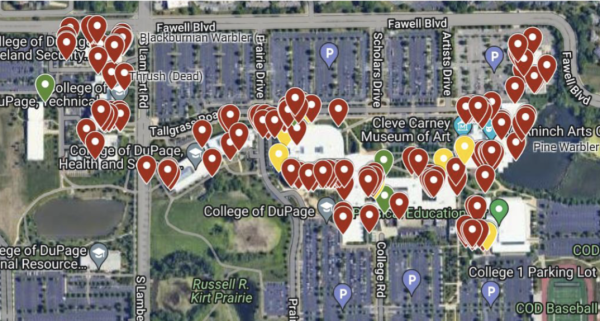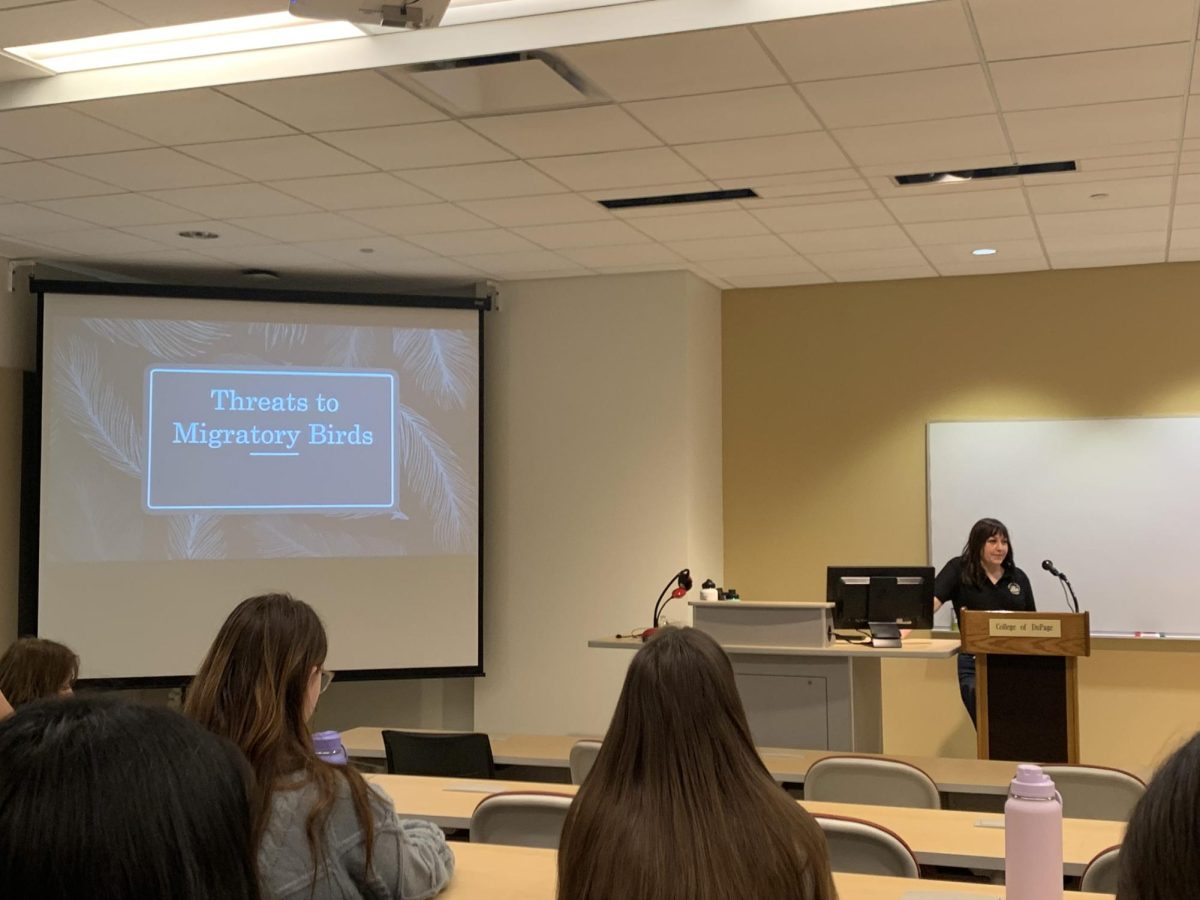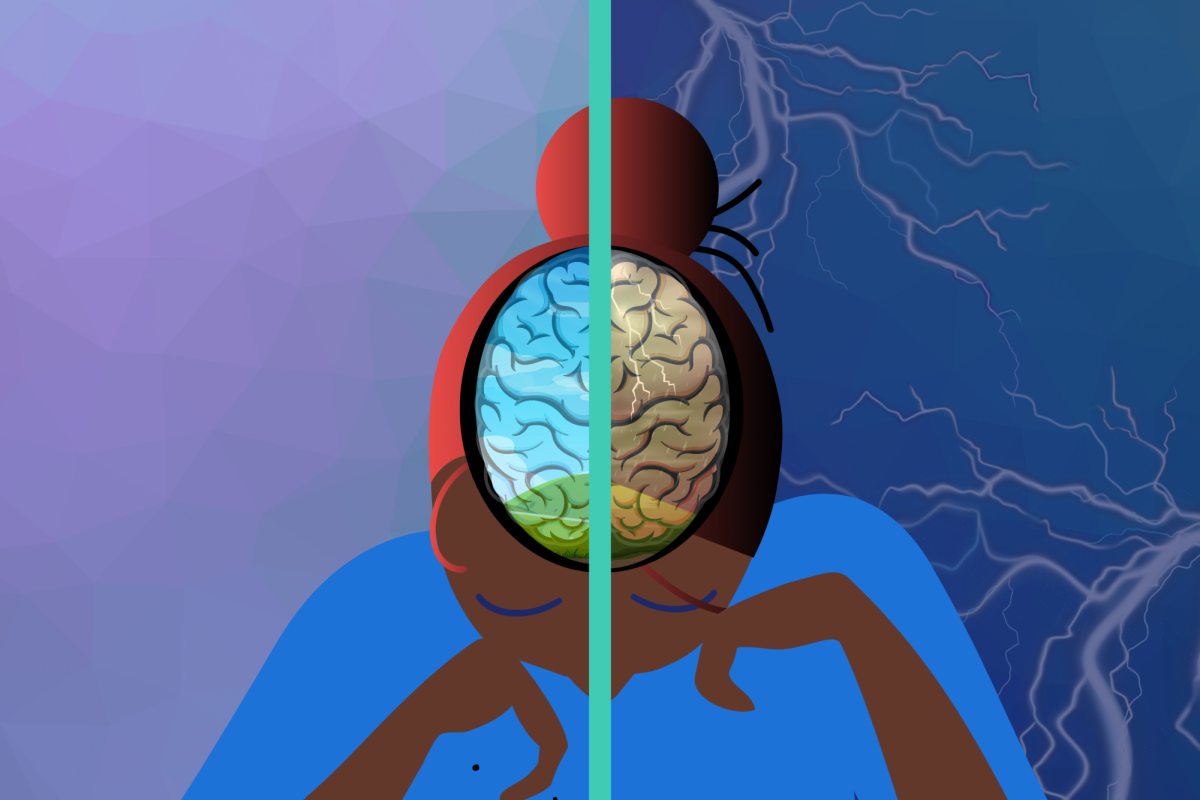Large, tall windows are a popular trend in modern city architecture, creating rooms that feel spacious and calming. But did you know that such windows pose a serious hazard to migrating birds across the country?
College of DuPage recently collaborated with the Willowbrook Wildlife Center, which is located less than five minutes from COD’s campus, to inform students about bird migration patterns, the threats they face in today’s urbanized landscape, and what they can do to help.
David Oullette, an assistant professor of art history at COD, provided background on how the issue of bird collisions initially caught his attention.
“Years ago I started noticing the presence of small dead songbirds,” he said. “Almost every morning, I would walk through, and I would see these dead birds and pick them up. I’d wrap them in a little paper towel. I’d bury them, and I’d go about my business. I started making notes on my phone about where I find them and when I find them.”
Witnessing such sights prompted Oullette to discuss his observations with artist Alice Hargraves, who had been creating a bird-strike-themed project. This inspired him to launch Bird Friendly COD, a student and staff initiative that aims to document and observe bird collision patterns on campus to find ways to prevent injury or death by strikes to local birds.
“I met an artist named Alice Hargraves, and her project at that time had been about bird strikes,” he said. “We had this big conversation about how we communicate bird strikes and what I could be doing differently and maybe help birds on our campus. This is when I came up with the idea for Bird Friendly COD, an initiative I began a few years back.”
Dyarra Barksdale, a biology student at COD, acknowledged that bird strikes are a prevalent issue that can be deterred.
“I learned that the Willowbrook Wildlife Center nurses injured animals and is near campus,” she said. “The panel solidified my opinion that bird collisions are preventable and should be addressed on campus.”
Data from 2023 collected by Bird Friendly COD indicates that the biggest on-campus hazard for birds is the Student Resource Center (SRC), followed by the McAninch Arts Center (MAC) and Berg Instructional Center (BIC).

Photo pulled from the 2023 Bird Strike Report for The College of DuPage.
Nate Hambel, a wildlife interpreter at the Willowbrook Wildlife Center, discussed the goals of the center in aiding native animals so they may thrive.
“Our goal is to release native wildlife back into the natural environment,” he said. “These are animals that live in this area or migrate through this area that generally are attracted to some kind of human-wildlife type of conflict. This isn’t a predator or prey problem. This is getting hit by a car. This is getting electrocuted, getting caught into litter, flying into windows. These are the types of issues that the animals have when they come to us.
“We rely on the community in order to bring them to us. We don’t have the resources to be able to go out there [to search for animals in need].”
Hambel provided a detailed background on bird migration patterns, including the migration routes of different species across North America, the varied distances different species travel (short, medium, or long), and why they migrate.
“We have 5 billion birds migrating north each year approximately,” he said. “The biggest reason is the food.”
Hambel detailed how birds decide to migrate depending on weather changes as well as the length of the day, noting how they must depend on doubling their weight as well as fat reserves to store energy for their lengthy flights, some of which last up to 18 hours.
Stephanie Touzalin, a Wildlife Education Supervisor at the Willowbrook Wildlife Center, discussed how the habits and migration patterns of birds collide with urban landscapes throughout North America.
“All the things that we’re talking about are natural challenges for these birds,” she said. “But when we introduce humans into the equation, we start to see some other challenges arise.”
Touzalin pointed out other major human-caused dangers besides large glass windows that birds tend to experience injury or death.
“We know that habitat loss and degradation are underlying all of these things and huge issues for these, but did anyone know that the number one killer of wild birds is cats? [It’s] 2.4 billion birds a year that they are killing, and the next [biggest cause] is building windows followed by vehicles, and then we have a lot of different causes, a lot of structures like wind turbines, power lines, communication towers, pesticides and other chemicals,” Touzalin described.
She talked about the dangers outdoor post lamps pose to birds at night, noting how they misdirect and exhaust migrating birds. She proposed lamp post design solutions that would keep both humans and birds safe at night.
“Lights are really dangerous at night,” she said. “They disorient the birds, and it conflicts with their navigational system. They’ll circle and get exhausted. We want to try to use lighting that is useful, targeted, low level, controlled and warm.”
Touzalin suggested ways to deter bird-window collisions including placing film, paint and decorations on windows, as well as placing bird feeders away from windows so that birds are less likely to collide with windows on the way to bird feeders.
As for protecting and nurturing birds in general, she suggested reducing plastic use that is often dumped in habitats and harms wildlife, planting flowers that serve as migration stops for birds to feed off nectar and insects, avoiding pesticide use, and drinking shade-grown coffee, which is coffee that is sourced from trees that serve as bird habitats.
Panel attendees were informed of the proper protocol to take in the case of encountering an injured bird: gently place the bird in a box or paper bag, ideally with a paper towel lining the inside of it and take the bird to a wildlife rehabilitator, keeping its environment dark and quiet in the meantime.
Hambel emphasized the importance of wildlife and habitat conservation especially during current environmental crises.
“Right now, we’re in a biodiversity crisis,” he said. “There are even theories out there that suggest we are in our sixth mass extinction. We are losing a significant amount of individual animals and individual species around the world. Who are we to determine which individual animal has more value over another?”
Natalie Malek, a criminology student at COD, said she was previously unaware of the prominent bird strike crisis at COD and expressed a desire to help COD’s initiatives to aid birds and prevent future collisions.
“I have not seen a bird injured or dead on COD’s outdoor campus before,” she said. “[The panel] gave awareness of what is going on to the bird population and what we should do to help take action. It allows me to spread information to other people and to bring even more awareness on what we can do to help save the birds.”
Barksdale said she would make it a point to take proper action in the case of encountering an injured or dead bird.
“If I see an injured bird, I’ll try my hardest to get it to the Willowbrook Wildlife Center,” she said. “Or at the very least, fill out the Bird Friendly form.”
COD students are encouraged to fill out the bird strike form upon seeing a dead or injured bird on COD’s outdoor campus. More resources regarding Bird Friendly COD can be found on the COD Library website. For more information







